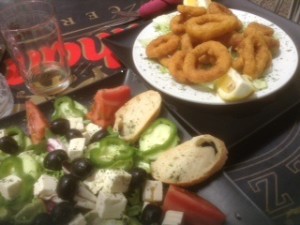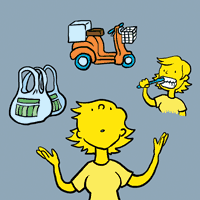Many thanks to Sara Toyn, Head of Adult Speech and Language Therapy, who has given us her thoughts on an organisational Talking Mats training course recently held in Powys, Wales. Together with Katie Earing, Sara organised the training course which included participants from a variety of NHS backgrounds and who worked with a range of adults with communication difficulties.
‘I attended a Talking Mats training organised by our team and offered to trained and untrained members of staff working in hospital and community. As an SLT I found it good revision and review of my own practice and also helped refocus some of my ideas and approaches.
The evaluations from all participants were extremely positive. We were overcrammed into too small a room as is the case with many training rooms and usually this is the first comment made on feedback. I think it is positive that no one mentioned this at all on the evaluations as everyone was very engrossed in the activities and videos. I have had several individuals point out how much they learnt and they report an increase in confidence in communicating with clients.’
Here are some of the comments from course participants
- This has opened up a whole new world of communication. Thank you.
- Very worthwhile course, have learned a lot and will surely use the mats at work.
- Feel I could integrate this into everyday practice with stroke patients – goal setting, D/C planning etc.
- Good interactive session.
- Completely unique! Thank you.
- Thank you. Excellent training, very transferable skills and will benefit patients.
- Really good. Being specific in the topic and phrasing questions openly, not only using Talking Mats.
- Have a patient in mind for tomorrow morning.
- Thank you. Really useful WHO ICF framework and framework for thinking about people’s cognitive level.
For further information about the training we offer, please click here
Thanks to Karen Wilson, a specialist teacher and one of our accredited trainers, who describes how Talking Mats can help in supporting Looked After Children in having their say.
‘I work as Principal Teacher for children with additional support needs in a mainstream secondary school. In supporting a wide range of children and young people, I am frequently involved in Looked After Children reviews. These reviews can be quite daunting for an adult, as all agencies involved with the young person are represented, along with their carers and their support agencies. I can’t imagine what it must feel like as the child.
Many of these young people find it difficult to express their views, partly because of the circumstances they find themselves in and partly because many of them have communication difficulties linked to their early experiences. I have been struck by how little information is often contained in their Having Your Say form. This should be one of the key ways for young people to express their views and is completed in advance of the review.
I recently used a Talking Mat to help a young person complete her ‘Having Your Say’ form. The young person reported that it was much easier to engage in the process and told me that she had enjoyed doing it. She normally does not like filling in the form. All of those involved in the review expressed surprise and delight at how much more information it was possible to get using a Talking Mat.
I am now working with Talking Mats to explore how this idea can be developed to give more of our Looked After young people a stronger voice in decisions which directly affect them.’
Have a look at the following blogs for further information on theTalking Mats GIRFEC resource and how it is being used
Many of you have requested the ability to add your own photos into the digital Talking Mat.The new version of the app allows you to do just that.
It is a great feature particularly, if you want to reflect on a particular activity like a day out or a holiday. I thought I would try it when I returned from my recent holiday in Spain . You can see I had a great time the only one downside was the flight (as for some strange reason my husband, Jon and I were not placed in adjacent seats) . I placed shopping in the middle (I might have done a little bit more but I know it’s not really Jon’s cup of tea so I restrained myself!). However there were lots of things I loved, seeing my son in his new apartment in Madrid was great, the walking in the Sierra Nevada stunning, though did involve a lot of up and down ! and Grenada, well, the Alhambra has always been somewhere I wanted to visit and it did not disappoint.
I know that in Talking Mats we have always been slightly cautious about the use of photos but I think where places are concerned and where the photos relate to the immediate experience of the person then they can be really helpful. However, I also think the difference in the image ‘going out for a drink’ and ‘meals out’ demonstrates clearly the pitfall of photos. In the ‘meals out’ photo that I took there is too much visual information and without the written caption you probably would struggle to guess what that photo means. The symbol of ‘going for a drink’ is much clearer and will work for lots of ‘going out for a drink’ situations.There is an additional risk that that the photo of my ‘meals out’ that I took becomes too specific to that particular meal rather than mean ‘meals out’ throughout the holiday if I had taken a photo of a more generic plate of food that might lessen that risk.
Maybe I should have used this photo!
Adding images from your camera roll is an easy feature to use. After you have selected your thinker and added a new session you get to the ‘session set up’ page. There is a button on the top left hand page that says ‘Add local image file’ click this and go to your camera roll. Select the image and type the caption. you can select as many images as you need. The images will then appear after the blanks when you carry out the Talking Mats session with your thinker.
I think this new feature of being able to add your own images means that you could use the Talking Mats in really creative ways. It would be a great way to reflect on a trip e.g. schools could use the photos to talk to the children about their experience of a particularly outing. This could be the basis of a great group discussion projected onto a white board. It could enable people to reflect and express their views on all type of experiences e.g. transitions, work experience, going to college, where to live, visiting their health centre etc.
If you already have the digital pro you will get a free upgrade to include this feature. If you don’t have the digital pro version and want it click here to buy
We are delighted to announce the release of Version 2 of the Talking Mats App
This app has a number of great new features which many of you have been asking for.
There are two new resources – Eating and Drinking – which has 3 main topic sets – Meals, Impact on Health and Things that might help.

There is an amazing new feature which many people have been asking for. Version 2 allows you to add your own images from your camera roll. This means that you can add you own personalised pictures to any of the topics.
Watch out for next week’s blog when Lois will tell you about her holiday using this new feature!
You can now also reset your password, use the Back button to navigate through the app, delete individual sessions and use the updated report page.
If you have already purchased the gold version of the Talking Mats app you will get all these new features for free.
If you wish to purchase the app please click here or for further information call our office 01786 479511
As part of the Right to Speak initiative Talking Mats was funded to develop ‘Promoting Inclusion and Participation’: an online learning resource for staff working with children and young people who use Alternative Augmentative Communication (AAC). We have been delighted to work with NHS Education Scotland on developing this free resource and also have really enjoyed working in partnership with the learning and development consultancy: Forum Interactive.
The complexity of care for children and young people who use Alternative and Augmentative Communication (AAC) is multifaceted. Ensuring that goals are centred on the young person and family’s needs is a constant challenge to practitioners. There are several resources that focus on developing the technical skills of developing AAC but there is a scarcity of resources that focus on the impact of AAC on the child’s day to day life.
Promoting Inclusion and Participation is based on an earlier project which determined the key indicators of a quality AAC service from the perspective of AAC users and their families.
Promoting Inclusion and Participation uses the following frameworks to help practitioners structure their decision making:
- International Classification of Functioning, Disability and Health – Children and Young People (ICF-CY)
- Janice Light’s Communicative Competencies (2014)
- GIRFEC (Getting It Right For Every Child) wellbeing indicators

This on-line resource will help practitioners:
- Understand the role that collaboration and involvement play in delivering wellbeing outcomes for children who use AAC.
- Apply a holistic approach and outcomes focused approach to assessment, implementation and review which places the child at the centre.
- Recognise that as the child develops and changes, so the level of different team member’s involvement will ebb and flow.
Download the resource here. It takes a little time to download so be patient !
We would be delighted to receive feedback of how it is being used.
Ref
Light J , Mcnaughton D, Communicative Competence for Individuals who require Augmentative and Alternative Communication: A New Definition for a New Era of Communication? Augmentative and Alternative Communication, 2014; 30(1): 1–18
 Online training login
Online training login 





